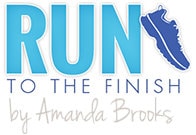Besides having the best name in all of running workouts, fartlek runs are also fun to do. The Swedish word means “speed play” and that’s exactly the intent of these workouts.
No need for a track.
No need for time recovery.
Nothing forced, but lots of benefits.
Fartlek runs are not only easy to incorporate into your running routine, but come with a bunch of benefits that can take your running to the next level.
Let’s dive into what a fartlek run involves and how you can start to incorporate them into your training (particularly if you’re new to speed work!).
What is Fartlek Training (Fartlek Run)?
Fartlek is a Swedish term that translates to ‘speed play,’ and so it literally refers to playing around with different speeds and paces, and is essentially a form of unstructured speedwork.
It was first developed by Swedish coach Gösta Holmér, after World War II, as a way of combining speed and endurance in one training session.
It teaches your body to incorporate varying speeds into a run, which can come in handy at the end of a race or during certain sections of a race when you want to take advantage of a downhill or realize you need just a few more seconds to crush that race goal.
So basically, fartleks are portions of fast running with no defined recovery period
Those portions of fast running are not long intervals, they are short.
For this reason, fartlek runs allow the runner to have a lot more control over their training sessions. By picking and choosing to mix a wide range of paces and lengths for your faster efforts, it allows you to become more in tune with running.
What’s the Difference Between Fartlek Runs, Interval Runs, and Tempo Runs?
If you feel that fartlek runs sound a lot like interval runs and tempo runs, I don’t blame you.
A fartlek is actually a type of interval run that incorporates short speed pick ups.
There are still some key differences between these, including the fact that fartlek is much more unstructured than intervals or tempo runs.
Fartlek involves continuous running with varying speeds.
Interval training involves running at a fast pace for a set time, followed by jogging at a slower pace for a set time or taking occasional breaks.
Tempo runs involve a warm-up, cool-down with time running at your threshold speed in the middle. It’s run at a consistent pace which is faster than an easy pace, but slower than a 5k, which is also referred to as a ‘comfortably hard’ pace you could potentially hold for an hour long race.
As you can see, fartlek almost combines the two in an unstructured way into one training session. The goal is to keep it flexible and run by feel rather than setting strict guidelines that you have to follow.
9 Benefits of Fartlek Training Runs
Fartlek training can really improve the way you train and condition your body and mind.
Here are some of my favorite benefits and then I’ll give you some specific workouts to try.
1. Great Way to Incorporate Speed Training
Fartlek training is an ideal way to work on speed training because it’s less intimidating for many new runners than strict intervals and more fun for long-time runners to break up high mileage weeks.
Additionally, recovery from a Fartlek run is much easier than a formal speed session.
By not having a structured way to go about it, you’re able to learn how to push yourself based on your current energy levels, rather than being focused on hitting a specific pace. This often leads to a more successful workout when it’s hot or you’re tired.
2. Adds Variety and Fun
Fartlek is all about playing around, with varying speeds and incorporating it into your training session at random moments, in turn, reducing the boredom you might feel creep up occasionally during endurance training.
Studies have shown that you’re more likely to stick with workouts you actually enjoy and fartlek is a great way to do this by adding variation to your regular running routine.
3. Preps You for Race Day
Fartlek runs teach your body to incorporate varying speeds into a run, which can come in handy at the end of a race whether you’re training for a 5K or a half-marathon.
Imagine those sections of a race when you want to take advantage of a downhill or realize you need just a few more seconds to crush that race goal, and your body remembers times when you’ve randomly asked it to go hard before.
During a race, there’s no stopping to rest between hard efforts. Fartlek runs allow you to continue running without needing a break like you might from a full-on track effort. In this way, they train your mind and body to show up on race day.
4. Understand Paces Better
Not only does it allow you to practice shifting between different paces, but it also helps you better learn what easy or recovery paces feel like after pushing hard.
By adding a variety of paces into one training session you get to run by feel and understand how your body is feeling at any given moment.
As you shift between paces, you’ll notice how your stride changes and what your body feels like. This becomes more helpful during structured intervals when you might have less recovery time and want to hit the same effort for each rep.
5. Gives You More Control
Fartlek training allows you to have more control of your speed workout, and to become more attuned to your body.
It allows you to make decisions about the workout based on how you’re feeling on a given day. We’ve all had a day where we know that the planned speed workout just isn’t possible based on either heat, ice, or our current energy levels.
Fartlek runs give you an opportunity to still incorporate some speed work, rather than just settling into an easy run.
Suddenly you are actively making decisions about the pace you want to run.
6. Keeps You Engaged
Fartlek runs can help runners stay focused and engaged.
These types of runs require the runner to remain attentive and focused since they require regular adjustments in pace dependent on factors and landmarks along the running route.
While zoning out during a run might be relaxing, paying attention to your pace and environment can help you become a better runner.
7. Time Efficient for a Great Workout
Fartlek runs are a great way to get in a high-intensity workout without spending hours on the track or road. It is an incredibly time-efficient form of speed training and can be done with minimal equipment, such as just a watch to monitor your pace.
The fartlek run allows you to incorporate different paces into a single run, while also giving you the freedom to adjust as needed and make decisions about how hard you want to push yourself. It’s an incredibly effective way to improve your speed and endurance without having to over-commit time or resources.
8. Helps Develop Mental Toughness
Fartlek runs can be mentally challenging because they require you to push yourself outside of your comfort zone. This type of training can help you develop mental toughness and the ability to push through discomfort and fatigue.
Mental toughness is an important trait for runners because it can help you push through tough workouts, races, and setbacks. This will help you stay focused and motivated, even when you’re feeling tired or discouraged.
By regularly incorporating fartlek runs into your training, you can develop the mental toughness you need to achieve your running goals.
9. Works Your Aerobic and Anaerobic Energy Systems
Fartlek runs will challenge your aerobic and anaerobic energy systems which will subsequently allow you to run faster.
Running at a steady pace allows your body to supply the oxygen it requires to feed your muscles. In this zone, your cardiovascular and aerobic fitness are being improved.
During the bursts of high-intensity running, your muscles don’t get enough oxygen, which works your anaerobic energy system. This is where you burn fat and build muscle, which makes you run faster.
Fartlek runs incorporate both to not only work your aerobic system but also your anaerobic energy systems.
Tips on How to Incorporate Fartlek into Your Training
Thanks to the unstructured nature of fartlek, there really is no right or wrong when it comes to incorporating them into your training sessions.
If you’re confused about how to incorporate them, here are a few tips:
Don’t Stop
Fartlek is all about a continuous run, so don’t stop in the middle. If you find yourself needing to stop quite often, you might be pushing yourself too hard. Try slowing down a bit.
Run by Feel
To run a good fartlek, run by feel instead of looking at your GPS for pace. In terms of efforts, vary between a 7-9 and then for the easy time slow down to a 4-6.
Don’t Worry Too Much
Fartlek is about fun. Don’t try to have a specific recovery or worry too much about pace. Have fun with what you set as your distance and intensity.
Use Your Environment
Depending on where you’re running, you can use the environment around you to add an unstructured fartlek session into your training (as they’re supposed to be).
Run from one landmark to another, use the terrain by running faster till you get to the top of the hill, use telephone poles, and run at a faster pace from one pole to another, returning to a normal pace afterward – you get my point.
If you’re still wanting to know more, I have some sample fartlek workouts for you to get started!
9 Examples of Fartlek Training
In any speed session, you should include a dynamic warm up and usually at least a mile of running before starting your first interval.
1. 3-mile Run with 5 x 30 seconds of Hard Effort
For a 3-mile run with 5 x 30 seconds of hard effort, you will begin with a dynamic warm up and at least one mile of easy running at a comfortable pace.
After completing the warm up and the first mile, you will begin your fartlek by sprinting for 30 seconds at a fast pace. After completing the 30 seconds, return to an easy running pace for recovery until you feel ready to repeat.
Repeat this 5 times, returning to an easy run pace between each hard effort until you have finished your 3-mile run.
2. 5 Mile Run with 10 x 1 minute of Hard Effort
For a 5-mile run with 10 x 1 minute of hard effort, you will begin with a dynamic warm up and at least one mile of easy running.
After completing the warm up and the first mile, you will begin your fartlek by sprinting for 1 minute at a fast pace. After completing the 1 minute, return to an easy running pace for recovery until you feel ready to repeat your fartlek run.
Repeat this 10 times, each time returning to an easy pace between each hard effort until you have finished your 5-mile run.
3. 6 Mile Run with 7 x 1 Minute Increasingly Hard Effort
For a 6-mile run with 7 x 1 minute increasingly hard effort, you will begin with a dynamic warm up and at least one mile of easy running at a comfortable pace.
After completing the warm up and the first mile, you will begin your fartlek by sprinting for 1 minute at a fast pace. After completing the 1 minute, return to an easy running pace for recovery until you want to do your second round of fartlek for another minute.
Repeat this a total of 10 times, while making sure to increase the intensity of each hard effort. Return to an easy pace between each hard effort until you’ve finished your 6-mile run.
4. Long Run with 1 minute of Hard Effort Every Mile
For a long run with 1 minute of hard effort every mile, you will begin with a dynamic warm up and at least one mile of easy running.
After completing the warm up and the first mile, you will begin your fartlek by sprinting for 1 minute at a fast pace. After completing the 1 minute, return to an easy running pace for recovery until you want to do your second round of fartlek for another minute.
Repeat this at each mile marker, returning to an easy pace between each hard effort until you’ve finished your long run.
5. No Watch Option
Sometimes you need to ditch the watch and STOP thinking about pace. A fun alternative is to pick certain landmarks during a run like lampposts or trees to act as starting and stopping points, we call these types of runs mind games for runners.
For example, you might pick a tree in the distance and run hard to it, then run easy until the next tree you spot a block or two further down.
6. Group Fartlek
If you do these at a track club workout, then they generally involve the coach calling out random amounts of time to speed up or slow down, which feels like a suspenseful game, a bit like duck, duck goose!
Fartlek workouts ARE NOT LONG EFFORTS.
These are not usually mile repeats or a steady state tempo run, fartleks tend to be shorter intervals for a few minutes or up to a 1/4 mile.
This is partially because you are doing them randomly throughout your run and the longer sessions would require a much longer total run.
7. Music Option
If you’re listening to songs while running, try running a bit faster during the chorus, or switch things around and run faster during the bridge. It’s all about adding variety to your sessions.
8. Cars
If your running route includes a lot of cars, you can use them to guide your fartlek run. You can pick a color, model, or make to guide when to run faster and when to slow down. For example, you may choose to run faster every time a red car passes by you and slow down when a silver one does.
9. Podcasts
When running while listening to a podcast, you can speed up during sponsor information or ads and ease back into a more relaxed pace throughout the show.
Can I Do a Fartlek Run on a Treadmill?
Yes, you can definitely do a fartlek run on a treadmill! The only difference between running outdoors and on the treadmill is that you may need to adjust the speed or incline settings to increase the intensity of your intervals. You can also change up your interval times for more variety.
To begin a fartlek workout on a treadmill, start with a warm-up at an easy pace for five minutes. Increase the speed and incline for 1 minute of hard effort, then return to your easy pace for recovery. Repeat this sequence 10 times, increasing the intensity of each interval as you go. Finish with a cool down at an easy pace.
You can also use other ways to structure your fartlek runs. If you watch TV while you run on the treadmill, you could use commercial breaks to do a speed interval. At the gym, you can make it a game by sprinting every time someone uses or leaves a machine near you.
You can also speed up when the chorus comes on or when certain songs on your playlist play. This can keep you from getting bored on the treadmill.
Are Fartlek Runs Good for Weight Loss?
Running for weight loss is a multifaceted thing, which is why I’ve written a whole ebook about what you need to know! But yes, they can be a useful tool in the process because you’re switching between fat burning with the lower intensity and increasing the total calorie burn with the intense sections.
Which leads to the next question of is fartlek a HIIT workout? No.
It doesn’t sustain the level of intensity that you would with a high intensity interval workout and it’s not designed to be used that way. You’d get more from a cardio + strength training session like Danielle Pascente if you want HIIT.
How Should I do a Fartlek Run?
Every training plan is different, but in general you want no more than two speed workouts per week. A fartlek counts towards those speed workouts.
If you’re a new runner, then fartleks can be an ideal way to start incorporating intensity without overdoing it. Your schedule might look something like this:
M: Rest
T: Fartlek
W: Easy
R: Interval
F: Rest
S: Easy
S: Long easy
If you’re working on improving speed, then you’ll also want to include a few other key pieces of training:
- How to do running strides — can include these at the end of easy days
- Running drills to improve your cadence
- Beginner speed workouts to also incorporate
- Understanding tempo runs
Tired of trying to figure it out alone? Jumping from plan to plan? Stop. Let our team of coaches help!
Other ways to connect with Amanda
Instagram Daily Fun: RunToTheFinish
Facebook Community Chatter: RunToTheFinish
Sign Up to Receive a Weekly Newsletter with Top Running Tips and Laughs






 Saucony Ride Vs Saucony Guide: Which is Right For You
Saucony Ride Vs Saucony Guide: Which is Right For You

dhruv.chandhok
sounds like a fun way to train.